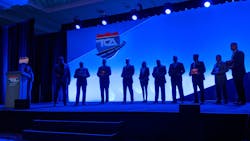Best Fleets to Drive For creates hall of fame for perennial top carriers
The annual Best Fleets to Drive For contest has grown so big in notoriety and participation that it needs another wing to celebrate the top North American carriers offering the best company culture for professional drivers.
Eight fleets that have continually been placed on the exclusive top 20 list by the Truckload Carriers Association (TCA) and CarriersEdge will be inducted into the Best Fleets to Drive For Hall of Fame at TCA’s 2022 convention in Las Vegas. Those eight hall of famers will be unveiled on Tuesday, Feb. 1, along with the 20 contest finalists and five more fleets to watch in 2022. Two winning fleets—one large carrier and one smaller carrier—will be named overall winners on the TCA stage in March.
“There are a group of fleets that tend to be on that list year after year—and they show no sign of leaving,” Mark Murrell, co-owner and president of CarriersEdge, told FleetOwner. “They belong there. They earn their place year after year. But the reality is that there’s a lot more than 20 that really are doing good things.”
Creating a ‘Hall of Sustained Excellence’
With several fleets making perennial appearances among the top 20 Best Fleets to Drive For, Murrell said it’s been harder for other top-performing carriers to crack that top 20. On top of that, the worthy fleets nominated for the recognition keep growing. For the first time in its 14-year history, more than 200 fleets were nominated by drivers.
The difference between the 20th place fleet and fleets that finish between 21st and 25th can be minuscule in final scores, Murrell said. “It's tough to look at it and say, well, that one doesn't belong there—they’re not a Best Fleet because they’re half a percentage point less.”
Rather than expand the top 20 finalists to more carriers, the Best Fleets leaders decided to create a special list for those companies that continue to succeed. The Best Fleets to Drive For Hall of Fame will debut with eight high-achieving carriers that have placed among the top 20 fleets for years.
But this isn’t your standard hall of fame, where once you’re inducted, you’re in for life. “It’s the Hall of Sustained Excellence,” Murrell explained. “The challenge with this is we don’t want to put them out to pasture because they’re still working. They’re still trying to do things. And because we know that things can change, we don’t want somebody in the Hall of Fame sort of trading on that three years from now when they’re not really at that level anymore.”
The hall of famers will have to requalify for the distinction each year. “That way, we'll ensure that they keep continuing to push,” Murrell said. “Also, they'll keep pushing everybody else forward too. Because when we score it, we just score the whole pile together.”
What makes a Best Fleet
To be considered by the Best Fleets program, carriers must be nominated by a professional company driver or independent contractor. The drivers are asked to recognize successes within their company’s culture, such as compensation, benefits, safety practices, equipment, training, and other intangibles. After the Best Fleets’ leaders go over the nominations, they reach out directly to the company to conduct deeper surveys about fleets’ policies and practices in search of the most innovative carriers on the road.
“This keeps an edge on us,” Rick Williams, founder of Central Oregon Truck Co., a member of the Daseke family of flatbed and specialized carriers, said when asked why his fleet continues to participate in the Best Fleets program. “It reminds us that we need to serve our driving team, and we need to have a good culture and make sure that we’re not missing the boat somewhere along the way—by looking at what other fleets are doing and really analyzing the whole package.”
Williams was speaking on a Best Fleets to Drive For podcast about why his fleet, a finalist for eight straight years, continues to participate in the contest. “Another great thing about Best Fleets is they look at the whole package of a company—not just pay or not just miles," he said. “They're looking at every single thing that you could possibly think of.”
Fleets are scored across multiple categories—the programs they’re offering drivers, the satisfaction of those drivers, and the results they’re seeing in safety and driver retention. “We count all three to measure how successful fleets are, but the program areas weighted most heavily in the final scores since that reflects the efforts the company is making,” Murrell explained.
“Comparing Hall of Fame against the Top 20, the Hall of Fame people were on average 8% better in their programs,” he continued. “While that doesn’t sound like much on its own, it’s important to note that these fleets are consistently operating at that level year after year—they’re not monumentally better, but they are noticeably better, and they’re noticeably better every year, which means they’re not only offering more, but they’re continuing to improve those offerings year after year.”
And how fleets are evaluated tends to change each year as the new ideas and technologies used by early adopters become the norm in the trucking industry. “For instance, the hall of famers were early adopters of ELDs and dashcams, earlier to implement guaranteed pay and salary programs, and earlier to start building out coaching programs for their drivers,” Murrell said. “While those things are now becoming standard across all Best Fleets finalists, the Hall of Fame fleets had a head start on them and are now further along in terms of program maturity.”
Murrell said the 20 finalist fleets that will be announced on Feb. 1 are also early technology adopters and have good driver support programs—“but the Hall of Fame fleets are just a level above them. We see it almost as tiers of business maturity.”
About the Author
Josh Fisher
Editor-in-Chief
Editor-in-Chief Josh Fisher has been with FleetOwner since 2017. He covers everything from modern fleet management to operational efficiency, artificial intelligence, autonomous trucking, alternative fuels and powertrains, regulations, and emerging transportation technology. Based in Maryland, he writes the Lane Shift Ahead column about the changing North American transportation landscape.

